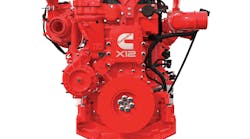To deliver the best uptime to fleets, it is critical to consider maintenance requirements when designing a new product or selecting key technologies to offer as part of an engine system.
An element of maintenance that could be easy to overlook by an engine manufacturer is access to parts. The harder parts are to access, the longer and more costly maintenance events can be for the fleet.
During maintenance or repair, speeding up the entire process gets vehicles back on the road more quickly.
Cummins took this into consideration when creating the X12 engine platform, designed to be more compact than engines that deliver similar horsepower. This allows technicians the ability to more easily access parts on the engine. The X12 platform shares many maintenance components with the X15 platform, using the same oil and fuel filters, and single module aftertreatment system, thus reducing inventory for multi-powered fleets.
Think beyond the engine
When integrating across the powertrain, it’s important to consider the maintenance requirements of components beyond the engine, such as the aftertreatment system and transmission, and how these components impact vehicle service.
The last thing fleets want is a complicated aftertreatment system behind their engine. With legislation that continues to demand more stringent emissions levels, it’s clear that aftertreatment technology needs to advance. That doesn’t mean, though, that the system has to be more difficult to manage.
The Single Module from Cummins is one example of an aftertreatment system that can meet these stringent emissions requirements without requiring extensive operator intervention. For instance, the diesel particulate filter (DPF) incorporated into this aftertreatment system is now about half the size of the DPFs offered on previous Cummins systems, yet its ash capacity has improved, requiring fewer regeneration and cleaning events. In fact, many first owners won’t even have to touch the filter for a cleaning, meaning that the filter is nearly maintenance-free.
The transmission is another critical powertrain component that sees demand for greater performance. Again, as technology advances, it may seem that maintaining the product would become more challenging, but that’s not always the case.
For example, the recently introduced Endurant transmission, from the Eaton Cummins Automated Transmission Technologies joint venture, features built-in diagnostics capabilities, like the fluid pressure sensor, to notify fleets when they are running low on oil. This alerts the fleet with enough time to take action, avoiding potentially damaging conditions, such as gear burn-up, that would require a lengthy and costly maintenance event. Other technology advancements include a clutch adjustment algorithm that checks and adjusts the clutch to maximize low speed and maneuverability and extend clutch life.
Beyond the hardware
It’s not just the maintaining of hardware that impacts vehicle uptime; how well the fleet is supported in their specific application or under specific operating conditions also matters. Often, that support stems from learning through various programs, service solutions and telematics, tuning fleets in to what’s happening with their operations.
It’s common practice to offer engines with recommended oil drain intervals. Yet, some fleet operations may be efficient enough to extend those intervals – it just takes some testing to determine that an extension would not harm the engine or impact its performance.
To address this issue, there are programs available to provide evaluation of current vehicle performance, such as the Cummins OilGuard program. In this program, the fleet provides oil samples at specified vehicle mileages, which are then extensively tested to validate whether or not their operations allow for an extension. Fleets granted extended oil drain intervals benefit from fewer interruptions to their operations, with less time and money spent in the shop. Vehicles spec’d with 2015 and 2016 ISX15 engines as well as the 2017 and 2018 X15 Efficiency and X15 Performance engines can currently utilize this program.
Customer support goes even further with the introduction of telematics. In today’s world of connected vehicles, seconds after a fault code is generated, a fleet manager or home office will learn what’s going on in the field. But, the amount of information that can be learned through telematics can be overwhelming, making it difficult for the fleet to make decisions about what actions they need to take next.
That’s where products like Cummins Connected Advisor come in. Programs like this can provide fleets with a prioritized list of service issues for Cummins engines, including estimated times to react. Fleets can address critical issues immediately, and have the ability to proactively schedule service for noncritical issues.
Continued optimization
While a lot can be done today to ease maintenance requirements, further powertrain integration will drive even more improvements for fleet maintenance operations. The more we learn, the more opportunities we can find to align engine, aftertreatment and transmission maintenance intervals or consolidate insights through telematics.
The quest to deliver the best uptime is not over, but continued experience and integration work will only bring us closer.
Jason Owens has spent over 30 years in the transportation industry, which includes 20 years of customer-facing roles at Cummins Inc. This work with both original equipment manufacturers and end users has given him great insight into the integration opportunities that exist within the powertrain category.


